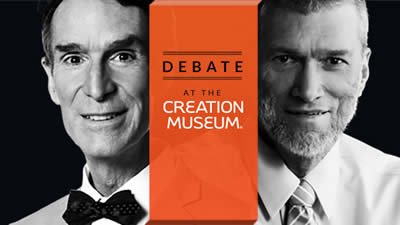
New Testament Scholar Says Creationists Are Honest But Not Truthful
It is not unusual for AiG to be misrepresented or for biblical creationists to be accused of misreading the Bible. The sad thing, however, is that this often occurs because people simply have not taken the time to understand what we believe. Recently, for example, New Testament Scholar Ben Witherington III wrote a blog post1 criticizing Christians who believe in biblical creation:
Have you noticed there is a difference between honesty and truth? A person can be as honest as the day is long, saying exactly what he believes to be true, and yet not tell the truth. Our culture has been suffering from truth decay for a long time, and a good deal of the talk about honesty and transparency has replaced a concern for truth in many quarters. Let me explain what I mean.
There are devout Christians who honestly believe the world is only about 6,000 years old, and that humans and dinosaurs roamed the earth together. You can see this sort of fervency at the Creation Science Museum in northern Kentucky . . . . These folks are honest, transparent, and completely convicted that they are telling the truth about the age of the earth. The problem is, they’ve misread not only the Bible (which says nothing about the age of the earth), but also the geological evidence. And in many cases, they are so fervent, that it is quite impossible to penetrate that armor with the truth. This is what the Bible calls ‘a zeal but not according to knowledge.’
Here is not the place to argue at length about this particular subject but a few points can be made: 1) when you go so far as to deny flatly basic scientific testing and evidence, such as carbon 14 testing, you are already on shaky ground; 2) when you go against the vast majority of scientist’s views on a subject, including most scientists who are Christians, you are on shaky ground; 3) when you start denying archaeological evidence as well, for example the evidence that the Gobeckli Tepe temple dates to 8-10,000 years B.C. near Urfa in Turkey, you are on shaky ground; and 4) when you refuse to take into account in the interpretation of the Biblical evidence that the Bible’s genealogies are not complete or exhaustive (so you can’t count back from Moses to the beginning of the human race) and that the Bible was not intended to be a scientific textbook anyway, downloaded on a pre-scientific era and a befuddled group of God’s people (which would have thoroughly confused them and been obfuscation rather than revelation), then you are on very shaky ground.
Reading Dr. Witherington’s blog, it does not seem that he has ever seriously taken the time to interact with the information available at Answers in Genesis2 (or with biblical creation material) that deals with his objections concerning biblical creation. This is unfortunate as honest criticism would require Dr. Witherington, as a scholar, to have checked what biblical creationists believe.
Nevertheless, all of Dr. Witherington’s objections have long been answered on our website.
1. Dating Methods—Carbon 14
First of all, biblical creationists do not deny scientific evidence or methods of measurement that are used to determine the age of things. However, what we do point out is that all evidence is interpreted through a bias and that all dating methods to interpret the evidence make several assumptions: 1) the initial conditions are known, 2) the decay rate has stayed constant, and 3) the amount of parent and daughter element is known not to have been altered by other processes in the past.
The specific dating method Dr. Witherington mentioned, Carbon-14, or C-14, actually confirms a young age for the Earth. C-14 breaks down relatively quickly with a half-life of 5,730 years. Material older than about 95,000 years should have no C-14, yet we still find it in coal and diamonds, which are supposed to be millions of years old.3 The fact that we find C-14 in diamonds confirms the biblical timescale of creation and is a problem for evolutionists.
2. Vast Majority of Scientists
While it may be true that the majority of scientists do not believe in biblical creation, it does not follow that we should simply accept what the majority believe (this argument undermines Jesus’ own teaching—see Matthew 7:13–14). This sort of claim is also disastrous to Witherington’s own belief in the miraculous. For example, the majority of scientists do not believe in the Virgin Birth, the Resurrection, or the miracles of Jesus. Yet would Witherington abandon his belief in these until scientists were persuaded by the “basic scientific testing and evidence”? The reason that the majority of scientists do not accept biblical creation is not because of the evidence—everyone has the same evidence to examine—but because it does not fit their worldview (Romans 1:18–20; 2 Peter 3:3–7). Rather than allowing Scripture to inform his understanding of the world, Witherington has uncritically accepted the testimony of scientists who work within a naturalistic paradigm that has controlled science for the past 150 years.
3. Archeological Evidence
Again, there are assumptions and biases that come into play when it comes to interpreting archeological evidence such as Göbekli Tepe.4 However, when interpreted through a biblical worldview, archeological evidence actually confirms biblical history.5
4. Genealogies Are Incomplete
This argument fails to take into account the fact that that even the authors of Scripture6 understood the figures contained in the chronologies in Genesis 1–11 were to be taken as strict chronologies (Jude 14).7 The genealogies in Genesis 5–11 are clearly chronological and deal with the chosen line of blessing, which serve to trace an unbroken line of descent from Adam to Jacob. The fact that they contain specific ages at the birth of each successive generation provides an unbroken timeline from Adam to Abraham. For this reason we can refer to them as chronogenealogies and distinguish them from the genealogies that occur elsewhere in the Bible.
Moreover, if the Bible is non-committal on the age of the Earth, as Witherington claims, then why is it that throughout church history most of the church fathers came to similar conclusions on how old the Earth is? As early as AD 181, Theophilus of Antioch wrote, “All the years from the creation of the world [to Theophilus’s day] amount to a total of 5,698 years.” Interestingly, Theophilus goes on to say of the chronology of the world set forth by the Greeks, “yet not of thousands and tens of thousands, as Plato and Apollonius and other mendacious authors have hitherto written.”8 The conflict over the age of the Earth is not new since it has always been a debate between pagans and Christians. Theophilus accepted that the chronology of the Bible was accurate and reliable as did the great theologian of the early church Saint Augustine. Even though he did not believe that the days were literally 24 hours, Augustine gave an answer to the assertion of those who ascribe to the world a past of many thousands of years:
Those who hold such opinions are also led astray by some utterly spurious documents which, they say, give a historical record of many thousand years, whereas we reckon, from the evidence of the holy Scriptures, that fewer than 6,000 years have passed since man’s first origin.9
The reformer John Calvin also believed that the world had not yet “completed its six thousandth year.”10 What is more, even scholars today recognize that when the genealogies are taken at face value the date for creation is around 4000 BC.11 This is because the days of creation, according to the text, are 24-hour days (Exodus 20:11). And from an understanding of the genealogies in Genesis 5–11, the creation would have occurred around 6,000 years ago.
Unfortunately, it is Dr. Witherington who is on “shaky ground” in accepting man’s fallible opinion over God’s revelation concerning Creation and the Flood. Dr. Witherington fails to see that his own armor is impossible to penetrate with the truth of Scripture in its teaching on creation because of his own fervency in holding to an old Earth.
A lesson to learn from this is that if you are going to criticize those with whom you disagree, then please do the honest thing and first read, or listen to, what they have to say.
Footnotes
- “The Honest Truth,” The Bible and Culture (blog), September 24, 2015, http://www.patheos.com/blogs/bibleandculture/2015/09/24/the-honest-truth/.
- He is obviously aware of AiG since he mentions the Creation Museum.
- See Andrew Snelling, “Carbon-14 in Fossils and Diamonds: An Evolution Dilemma,” Answers, January–March 2011, https://answersingenesis.org/geology/carbon-14/carbon-14-in-fossils-and-diamonds/.
- See David B. Smith, “Overturning Expectations About Ancient Man: Monuments at Göbekli Tepe,” Answers, April–June 2014, https://answersingenesis.org/archaeology/ancient-technology/overturning-expectations-about-ancient-man/.
- See Clifford Wilson, “Does Archaeology Support the Bible?,” The New Answers Book (Green Forest, AR: Master Books, 2006), https://answersingenesis.org/archaeology/does-archaeology-support-the-bible/.
- James Barr, Oriel Professor of the interpretation of the Holy Scripture, Oxford University, England, in a letter to David C.C. Watson, April 23, 1984. Barr, consistent with his neo-orthodox views, does not believe Genesis, but he understood what the Hebrew so clearly taught. “. . . probably, so far as I know, there is no professor of Hebrew or Old Testament at any world-class university who does not believe that the writer(s) of Genesis 1–11 intended to convey to their readers the ideas that: the figures contained in the Genesis genealogies provided by simple addition a chronology from the beginning of the world up to later stages in the biblical story . . . .,” (https://answersingenesis.org/genesis/oxford-hebrew-scholar-professor-james-barr-meaning-of-genesis/).
- For a persuasive analysis and defense of a no-gap chronology in Genesis 5–11, see Travis R. Freeman, “Do the Genesis 5 and 11 Genealogies Contain Gaps?” in Coming To Grips with Genesis: Biblical Authority and the Age of the Earth, ed. T. Mortenson and T. H. Ury (Green Forest, AR: Master Books, 2008), 283–313.
- See Theophilus, 3:28, 29 - Theophilus of Antioch. 180–185 AD. Theophilus To Autolycus Book III. Retrieved from http://www.earlychristianwritings.com/text/theophilus-book3.html.
- Augustine, City of God. (London: Penguin Books, 2003), 484.
- John Calvin, trans. Henry Beveridge., Institutes of the Christian Religion. 2nd ed. (Peabody, Massachusetts: Hendrickson Publications, 2009), 90.
- For example, Gerhard Hasel, who was professor of Old Testament and Biblical Theology at Andrews University, calculated from the Masoretic Text that Creation took place at 4178 BC. G.F. Hasel, “The Meaning of the Chronogenealogies of Genesis 5 and 11,” Origins 7, no. 2 (1980): 53–70.
Recommended Resources

Answers in Genesis is an apologetics ministry, dedicated to helping Christians defend their faith and proclaim the good news of Jesus Christ.
- Customer Service 800.778.3390
- © 2024 Answers in Genesis







